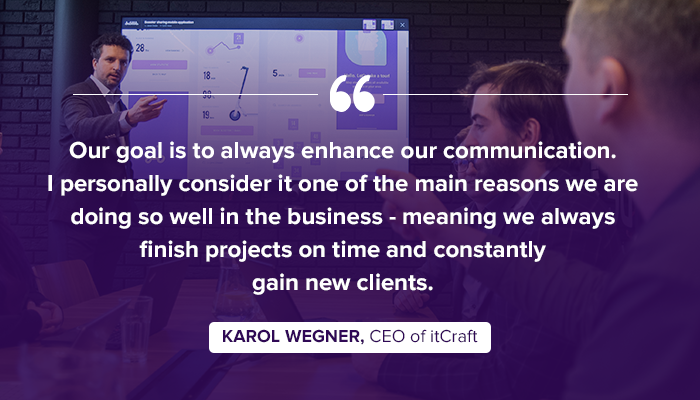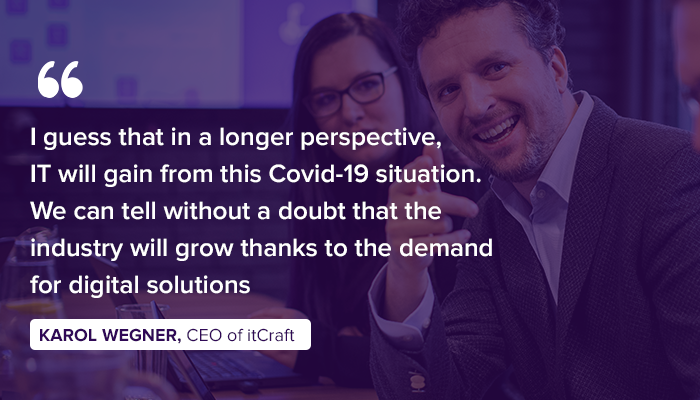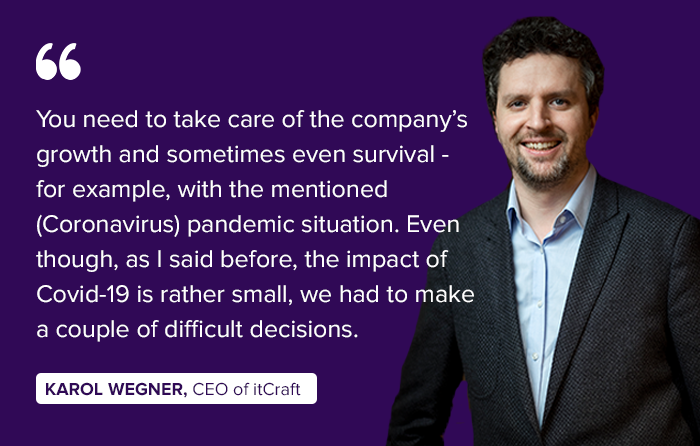Karol Wegner, the CEO of itCraft, sees his journey in hindsight from being a developer, tech leader, and project manager to holding the reins of itCraft. In an exclusive tête-à-tête with MobileAppDaily, he shares valuable insights on the company’s value propositions, challenges in the inceptive years and the promising project of developing the Homedoctor app.
 Full Interview
Full Interview
1) From your days of being the developer to holding the reins of itCraft, how has the journey been?
First of all, I’ve started as a developer and my primary language was Java. I was then promoted to Tech Leader and Project Manager. During this time, my friend and I, Bartosz Pieślak (co-owner of itCraft), were thinking about opening a company. We did that in 2010 and since then, it has been a fantastic journey.
We’ve invested a lot of time and effort into itCraft’s growth. Now we are highly contented with our current position. Our team has more than 65 people and our ambition is to expand even more. I still have a lot of energy and an urge to see what’s next for us.
2) What were the challenges that you faced during the inceptive years?
There have been so many of them! Before founding itCraft in 2010, we’ve spent a couple of years working in a big corporation. We’ve had almost no experience when it comes to running a business, so we had to learn all the procedures for the first couple of years.
We’ve started by doing our first sales by ourselves only. Then we’ve been hiring employees and afterwards, we’ve opened our first office space. Our next goal was to get bigger projects. To be honest, the challenges never end. Now they are just on a different scale and affect different areas of our operations. I think one of the most significant changes we went through was our evolution from developers to business managers. And I think we’ve achieved that with success. Now our primary goal is to grow the company even further.
3) When clients approach with an application idea, which platform(s) do you suggest- Android, iOS, or cross-platform, and why?
That is a big question. There are many factors here and most of them we discuss in our recent ebook. I really recommend downloading and reading it as it answers many issues when it comes to choosing development technologies.
The short answer would be this: the technical requirements of the project determine the choice - never the opposite. People that approach us with a project often tell us we should pick this or that option when it comes to tech stack. And that’s usually not the best idea. In some cases, that can lead to a disaster. You should think your project through, write down all the requirements, understand the context of the project and then we can pick the most suitable technology. That is the right way to do it.

4) What unique value propositions does itCraft offer? What makes it stand apart from its contemporaries?
First of all - quality. It always speaks for itself. That means, of course, that our offer is not always competitive price-wise. But our clients still claim that choosing itCraft was the right decision because of the quality we delivered - and I think their positive reviews testify all of it.
Another value we genuinely care about is communication - both internally between team members and externally with the clients. Speaking of our team, Agile methodology was one of the main improvements when it comes to communication. We also use the principles of Scrum development. Our goal is to always enhance our communication. I personally consider it one of the main reasons we are doing so well in the business - meaning we always finish projects on time and constantly gain new clients.
The third value I would like to mention is being comprehensive when it comes to offered services. We know how to lead a project from when it’s just an idea. We analyze the requirements and based on that, we create UX and UI design, implement all the components and then test all of this to deliver the final product.
5) Has the demand for platforms like React Native and Flutter dented the scope for Native applications? What do you suggest?
I don’t think it’s entirely like that. At some point, new technologies expand the stack of any experienced software house that is looking for new opportunities. For some particular projects, cross-platform solutions might be a better choice than native. But we can’t develop all products in Flutter or React Native.
Most advanced mobile applications are not done with cross-platform because it requires some kind of compromise. It is an excellent choice for entirely new, innovative startups and Minimum Viable Products (MVP). But for final, high-quality solutions, we recommend native technologies.

6) While developing a mobile application, cost becomes one of the most critical and compromising factors. What points are necessary to finalize the app development pricing?
The way we estimate our projects are based on our expertise. Thanks to our years of experience, we can present the initial estimation quite early. That’s because we’ve done so many projects and we know more or less how much it will cost to develop a particular solution. So in the beginning, we can give the client a budget range they should prepare.
The final estimation, on the other hand, is influenced by many factors. We always suggest starting with the UX workshops we organize. Afterward, when the Product Owner cooperates with the UX and UI design team, as well as the project manager and developers, to create the prototype, we can really predict what features are going to be required for the project. Only at this stage, we can create a detailed cost estimation.
We all know that large-scope products are almost impossible to be estimated precisely. The majority of our projects are led in Agile and Scrum, so we usually estimate the costs of separate production stages. During each sprint, we update our calculations and after a couple of them, we can tell more about the final cost of the project.
7) The global economy has been shaken by the impact of Covid-19. How is itCraft coping with the pandemic’s impact?
In February and March, we had a little panic mode. Some of our projects were put on hold and we also lost a couple. Now, since April, we do not only see stabilization in our industry but actually a slightly higher demand for our services.
I guess that in a longer perspective, IT will gain from this Covid-19 situation. Of course, that also depends on how the whole economy will handle the crisis - and the predictions suggest that instead of 1 to 3 months, it might last 2 to 3 years. But still, we can tell without a doubt that the IT industry will grow thanks to demand for digital solutions that allow the users to order products online and use services without leaving their homes.
8) How much does diversity matter for an IT agency when it comes to taking up projects?
At itCraft, we hire both talented women and men, but gender is not a criterion during our recruitment processes. What matters are individual skills, competences, and potential. We recognize though that, as an IT company, we hire exceptionally many women. That’s a great sign - more and more people are getting interested in this industry.
9) What is the most interesting offbeat app that itCraft has worked on? Would you like to spill some details?
We’ve done a lot of mobile projects so it’s hard to point just one. Many of them are extremely interesting and promising. One that comes to mind is HomeDoctor - a constantly growing healthcare industry startup dedicated to ordering medical home visits. It’s a solution perfectly adjusted to current times.
The whole pathway of this company was pretty eventful. In the beginning, they were quite innovative in their market, so the reactions varied. Some people were enthusiastic about the whole idea; others thought it was way too niche. But they found their own way of expansion. For instance, they decided to cooperate with more prominent players from the private healthcare sector.
We are proud that we could be a part of the app development for HomeDoctor and we keep our fingers crossed for the whole project to get even more recognition.

10) What is the best and worst side of being a CEO?
Indeed, it’s a role that has its advantages but also its share of drawbacks. The whole team pins its hopes on the CEO. It also requires a lot of responsibility and I think that’s one of the toughest things about it. You need to take care of the company’s growth and sometimes even survival - for example, with the mentioned pandemic situation. Even though, as I said before, the impact of Covid-19 is rather small, we had to make a couple of difficult decisions.
At the same time, this responsibility is also one of the best things about being a CEO. That’s because our decisions (made together with Bartosz, the co-owner of itCraft) shape the company’s further development. This process of creation that leads to growth is truly magnificent.
11) What is the single most important piece of advice you have received in your career?
I’ve received a lot of different advice and so much support, too. It is hard to distinguish a particular one that helped me the most during these years. My tip here is always to be open to receiving them. When we already have our own experience, it is harder to learn from others, but in the beginning, we should embrace what they can teach us. At the same time, remember not to take all the advice without criticism - common sense will help you avoid unfriendly people trying to use you for their own ends.
Key Takeaways
- The itCraft team has more than 65 people and their ambition is to expand further.
- According to Karol, the technical requirements of the project determine the choice of platform.
- Karol believes that the right approach is to think your project through, write down all the requirements, understand the context of the project, and then pick the most suitable technology.
- According to Karol, quality, communication, and comprehensiveness are the three values of itCraft.
- Korol believes that cross-platform solutions might be a better choice than native for some particular projects but we can’t develop all products in Flutter or React Native.
- Karol recommends native technologies for final, high-quality solutions.
Interested in authoring a guest article or narrating your start-up journey for MobileAppDaily?
Unveiling the pulse of mobile tech, our expert author at MobileAppDaily is your guide to the latest trends and insights in the app development sphere. With a passion for innovation, they bring you succinct analyses and a keen perspective on the evolving world of mobile technology. Stay tuned for concise updates that decode the future of mobile apps.
Are you one of the disruptors too?
We’d love to feature you.










